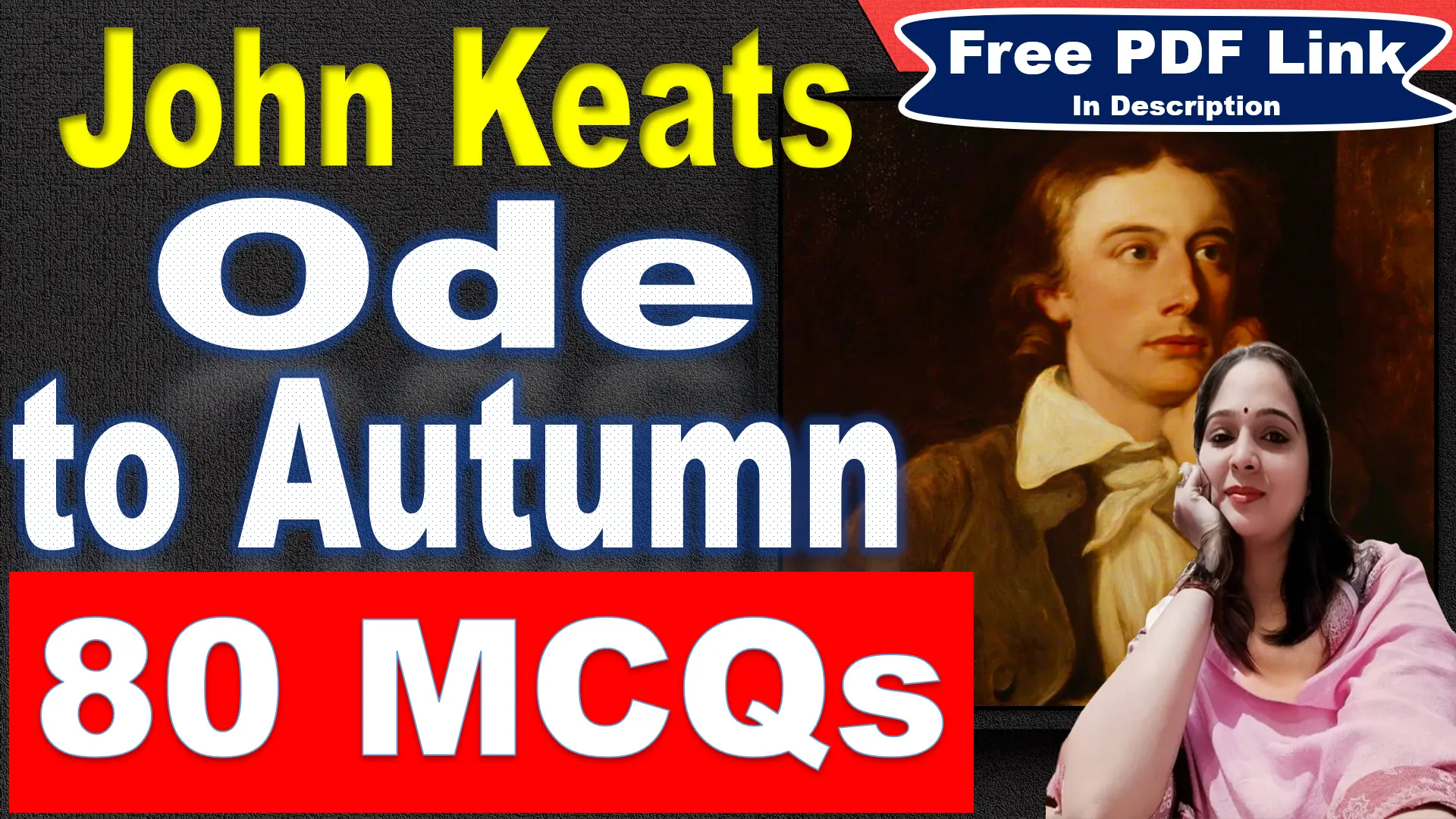
Essay Type Questions
Write the critical appreciation of the poem “The Last Ride Together”.
Introduction
The Last Ride Together is one of Robert Browning’s well-known dramatic monologues, first published in his 1855 collection Men and Women. The poem explores unrequited love, acceptance, and the human search for happiness through the reflections of a rejected lover. Browning’s unique approach to love, focusing on self-reflection and philosophical thoughts, turns this poem into a deeper exploration of human emotions rather than a traditional love poem.
Central Idea
The main idea of The Last Ride Together is the speaker’s acceptance of his unreturned love and his search for meaning and satisfaction despite his disappointment. Instead of becoming bitter, he requests one last shared moment—a final ride with his beloved. This ride becomes symbolic, representing his attempt to find beauty in a short, meaningful experience. The poem ultimately shows that life’s greatest joys often lie in brief moments rather than in achieving perfection or grand goals.
Structure & Rhyme Scheme
The poem has ten stanzas, each with the rhyme scheme AABBCDDEEEC. This structured rhyme gives the poem a steady musical quality that supports its reflective tone. Browning uses iambic tetrameter (four beats per line), which gives a smooth, flowing rhythm that matches the speaker’s calm reflections. This consistent meter and rhyme scheme add to the poem’s thoughtful, dreamy mood as the speaker goes on his “last ride.”
Theme
Unrequited Love and Acceptance: The speaker’s love is not returned, but instead of being heartbroken, he accepts it with grace, choosing to enjoy one last ride together.
Living in the Present Moment: Browning emphasizes the importance of appreciating the present. The speaker finds satisfaction in the ride, suggesting that happiness can come from valuing what we have now instead of constantly seeking a better future.
The Limits of Human Ambition: The speaker reflects on how people—like soldiers, poets, and statesmen—strive for greatness but often fall short. This suggests that understanding life’s limits may lead to greater peace.
Art vs. Life: Browning contrasts the beauty of real-life experiences with artistic ambitions, suggesting that personal, lived moments like the ride can be more fulfilling than trying to achieve perfection through art.
Style
The poem is written as a dramatic monologue, focusing on the speaker’s inner thoughts. Browning’s conversational tone and use of questions create a natural, reflective style. Through the speaker’s personal dialogue, Browning explores deep human emotions, making them feel real and relatable. His style uses vivid imagery and metaphors, helping readers understand the speaker’s feelings and making the poem a thoughtful meditation on love and acceptance.
Poetic Devices
Imagery: Browning uses vivid images, like “life’s flower” and “the glory-garland,” to show the speaker’s emotions and the beauty of the ride.
Metaphor: The ride itself is a metaphor for the speaker’s journey through love, life, and acceptance.
Personification: Abstract ideas like “Art” and “Heaven” are personified, making complex concepts more relatable.
Rhetorical Questions: The speaker’s rhetorical questions, such as “What if heaven be that, fair and strong,” reveal his doubts and thoughts, adding depth to his reflections.
Alliteration: Phrases like “freshening and fluttering” create rhythm and highlight the emotional impact of the speaker’s experience.
Anaphora: Browning uses anaphora in lines like “What if we still ride on,” repeating the phrase to emphasize the speaker’s longing for an endless, timeless ride. This repetition highlights his wish to make the present moment last forever, as he imagines heaven as an endless continuation of the ride.
Repetition: The repeated phrase “ride, ride together” in the final stanza shows the speaker’s desire to extend this experience, adding a sense of timelessness and unity.
Critical Commentary
Critics have praised The Last Ride Together for its exploration of human emotions and philosophical themes. Literary critic James Fotheringham admired Browning’s ability to mix deep emotion with intellectual thought, noting that the poem emphasizes acceptance rather than traditional romance. Scholar Isobel Armstrong called it “a thoughtful look at the human search for meaning, embracing both disappointment and fulfillment.” Some critics believe the poem reflects Browning’s own views on life’s limits, showing a preference for acceptance over chasing unreachable goals.
Message
The message of The Last Ride Together is that true happiness may come from accepting life as it is and finding beauty in short-lived moments. The speaker’s journey shows that unfulfilled dreams and unreturned love don’t have to lead to sadness. Instead, they can lead to peace and deeper understanding. Browning suggests that life’s beauty often lies in small, meaningful experiences rather than in big achievements or perfection.
Conclusion
The Last Ride Together is a deep reflection on love, life, and the search for happiness. Through Browning’s use of dramatic monologue, vivid imagery, and poetic devices like anaphora and rhetorical questions, readers are drawn into the speaker’s personal journey. By exploring themes of unrequited love, human ambition, and the beauty of the present, Browning’s poem suggests that fulfillment might come from appreciating life’s moments as they are. The poem’s message encourages us to embrace life’s imperfections and find joy in the simple, fleeting experiences we share.
Long note on themes of the poem “The Last Ride Together“.
Unrequited Love and Acceptance
In The Last Ride Together, the speaker begins with a moment of rejection but responds with a calm and accepting heart. Rather than letting bitterness consume him, he asks for one final ride with his beloved, focusing on the shared experience. His response to unreturned love reveals maturity and an ability to see beauty even in situations that fall short of his dreams. Though their future together may be over, he finds happiness in the fleeting moment they can still share.
Living in the Present Moment
Browning presents a message of embracing the present, as the speaker decides to fully savor this last ride rather than lamenting over what might have been. By living in the moment and appreciating his time with his beloved, he discovers joy in simply being together, even for a short while. This theme suggests that focusing on the present can offer a sense of peace that is often more fulfilling than chasing after an uncertain future.
The Limits of Human Ambition
Reflecting on human aspirations, the speaker considers the drive that leads people to pursue greatness—soldiers chasing glory, statesmen striving for fame, and artists crafting beauty. Yet, he observes that these ambitions are often met with frustration, as few manage to achieve all they seek. This acceptance of life’s limitations underscores a truth: though human desires are vast, disappointment is common. The speaker recognizes this and accepts that while his love may not be everything he once dreamed of, it still holds significance.
Art vs. Real Life
Browning contrasts the experience of life with the beauty of art. The speaker muses on how artists—poets, musicians, and sculptors—devote their lives to creating expressions of love, glory, and beauty. Yet, for him, no artwork could compare to the real-life experience of riding with his beloved. This reflection emphasizes that, while art can capture glimpses of beauty, it often falls short of the richness found in genuine, lived moments.
Imagining Heaven as a Perfect Moment
As the poem unfolds, the speaker begins to envision heaven as a perfect, timeless moment on earth. He wonders if this final ride with his beloved could be his version of paradise, where they remain in a state of connection and contentment forever. This idea offers an alternative view of heaven—not as a faraway place but as an unforgettable moment that stands outside time. For him, paradise is not a destination but a feeling, a treasured experience that holds more than any imagined afterlife.
The Shortness of Life and Beauty
Acknowledging the fleeting nature of life’s beautiful moments, the speaker embraces the fact that these experiences are often brief. He realizes that the brevity of life and love makes each moment more precious, and rather than being saddened by life’s impermanence, he finds meaning in it. This perspective suggests that the beauty of life lies in its transitory nature, urging us to appreciate what we have in the present without taking it for granted.
Thoughts on Success and Failure
In his reflections, the speaker contemplates the meaning of success, observing that people often work tirelessly but fall short of their dreams. Soldiers may fight with valor, but their deeds can fade from memory; poets may pour themselves into their art, but their works may go unrecognized. He begins to see that success and failure are often shaped by forces beyond our control, and that true fulfillment might not come from accolades or achievements. Instead, he finds a form of success in the simple joy of sharing a meaningful experience with his beloved. This reflection suggests that genuine satisfaction may stem from personal moments and relationships rather than external measures of success.





